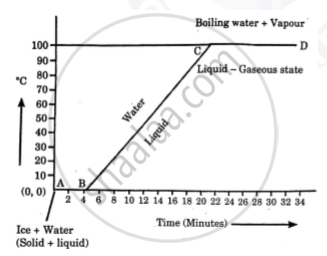Advertisements
Advertisements
प्रश्न
When ice is converted into water : constant temperature : : before the water evaporates : _______
उत्तर
When ice is converted into water : constant temperature : : before the water evaporates : temperature is increasing
APPEARS IN
संबंधित प्रश्न
State two factors upon which the rate of emission of thermions depends.
State the effect of an increase of impurities on the melting point of ice.
Explain the following:
The surrounding become pleasantly warm when water in a lake starts freezing in cold countries.
The S.I. unit of specific latent heat is ______.
Calculate the total amount of heat energy required to convert 100 g of ice at −10℃ completely into water at 100℃. Specific heat capacity of ice = 2.1 J g-1 K-1, specific heat capacity of water = 4.2 J g-1K-1, specific latent heat of ice = 336 J g-1.
Explain the following temperature vs time graph.

Liquid ammonia is used in ice factory for making ice from water. If water at 20°C is to be converted into 2 kg ice at 0°C, how many grams of ammonia are to be evaporated? (Given: The latent heat of vaporization of ammonia = 341 cal/g)
Explain the following temperature Vs. time graph:

Define the following terms:
(i) Latent heat,
(ii) Latent heat of fusion of ice.
What do you understand by the ‘latent heat of vaporization’ of a substance?
Explain the meaning of greenhouse effect.
What observation you will record and how will you determine the specific latent heat of fusion of ice?
Specific latent heat of vaporisation : J/kg : : specific heat : _______
Find the odd one out and give its explanation.
Write scientific reason.
Even if boiling water is constantly heated, its temperature does not rise.
Write scientific reason.
Use a pressure cooker to cook food in cold air.
For the same mass of ice and ice-cold water, why does ice produce more cooling than ice-cold water?
Observe the following graph and answer the following questions:

- What does the graph represent?
- What does the line AB represent?
- What does the line BC represent?
